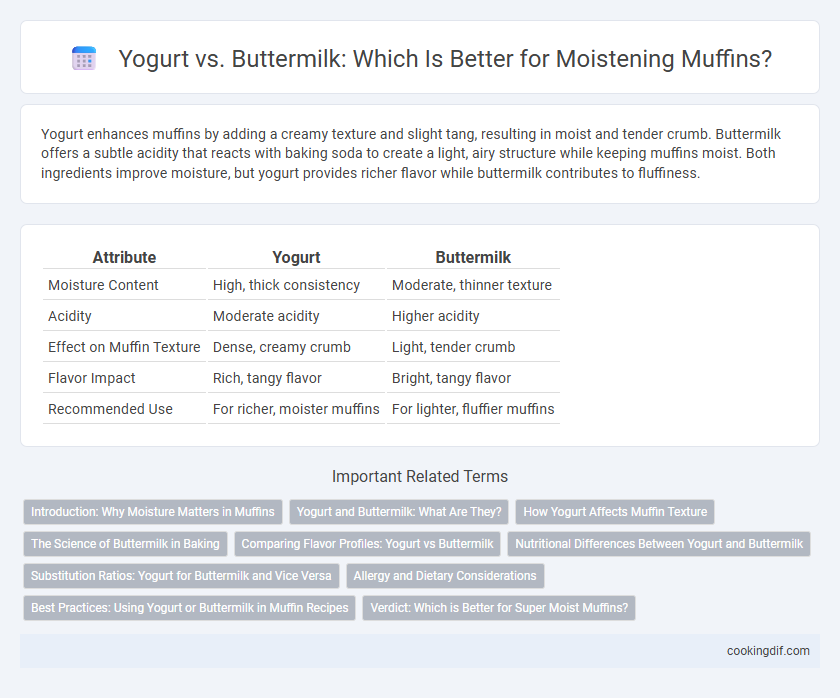Yogurt enhances muffins by adding a creamy texture and slight tang, resulting in moist and tender crumb. Buttermilk offers a subtle acidity that reacts with baking soda to create a light, airy structure while keeping muffins moist. Both ingredients improve moisture, but yogurt provides richer flavor while buttermilk contributes to fluffiness.
Table of Comparison
| Attribute | Yogurt | Buttermilk |
|---|---|---|
| Moisture Content | High, thick consistency | Moderate, thinner texture |
| Acidity | Moderate acidity | Higher acidity |
| Effect on Muffin Texture | Dense, creamy crumb | Light, tender crumb |
| Flavor Impact | Rich, tangy flavor | Bright, tangy flavor |
| Recommended Use | For richer, moister muffins | For lighter, fluffier muffins |
Introduction: Why Moisture Matters in Muffins
Moisture plays a crucial role in muffin texture, influencing softness, crumb structure, and overall mouthfeel. Yogurt, rich in protein and natural fats, adds a creamy consistency that helps retain moisture while enhancing flavor complexity. Buttermilk, with its acidic properties and lower fat content, tenderizes gluten and contributes a subtle tang, preventing dryness and promoting a moist, tender crumb.
Yogurt and Buttermilk: What Are They?
Yogurt is a fermented dairy product made by adding bacterial cultures to milk, resulting in a creamy texture and tangy flavor that enhances muffin moisture and tenderness. Buttermilk, traditionally a byproduct of churning butter, is now typically cultured by fermenting low-fat milk with lactic acid bacteria, providing a slightly sour taste and acidic pH that reacts with baking soda to create light, fluffy muffins. Both yogurt and buttermilk contribute moisture and acidity, improving the crumb structure and overall softness of muffins, but their unique fermentation processes impart distinct flavors and textures.
How Yogurt Affects Muffin Texture
Yogurt enhances muffin texture by adding moisture and creating a tender crumb due to its creamy consistency and natural acidity. The lactic acid in yogurt reacts with baking soda to produce carbon dioxide, resulting in a light, fluffy interior. Compared to buttermilk, yogurt often yields a richer taste and denser yet moist muffins, improving overall mouthfeel.
The Science of Buttermilk in Baking
Buttermilk contains lactic acid that reacts with baking soda, producing carbon dioxide bubbles that help muffins rise and develop a tender crumb. Its acidity also breaks down gluten proteins, resulting in a moister, softer texture compared to yogurt's thicker consistency. The higher moisture content and enzymatic activity in buttermilk contribute to superior crumb structure and enhanced flavor development during baking.
Comparing Flavor Profiles: Yogurt vs Buttermilk
Yogurt adds a creamy tang and subtle sweetness to muffins, enhancing their moist texture while providing a rich, slightly tart flavor. Buttermilk contributes a sharper acidity and a lighter, fluffier crumb, which intensifies the muffin's tanginess without overwhelming sweetness. Choosing between yogurt and buttermilk depends on the desired balance of moisture and tang, with yogurt offering a thicker texture and buttermilk promoting lighter, airy muffins.
Nutritional Differences Between Yogurt and Buttermilk
Yogurt provides higher protein content and probiotics, enhancing gut health and aiding digestion in muffins, whereas buttermilk offers lower fat and calories, contributing to lighter texture and tangy flavor. Buttermilk contains more calcium and vitamin B12, essential for bone strength and energy metabolism, while yogurt is rich in potassium and vitamin D, supporting cardiovascular and immune functions. Choosing between yogurt and buttermilk for muffins depends on desired nutritional benefits and moisture balance in the final baked product.
Substitution Ratios: Yogurt for Buttermilk and Vice Versa
Yogurt and buttermilk can be substituted for each other in muffin recipes using a 1:1 ratio, maintaining similar moisture and acidity levels. Greek yogurt, being thicker, may require thinning with a tablespoon of milk per cup to match buttermilk's consistency. Using these substitution ratios preserves the tender crumb and balanced flavor essential for moist muffins.
Allergy and Dietary Considerations
Yogurt and buttermilk both enhance muffin moisture, but yogurt is often preferred for allergy and dietary considerations due to its lower lactose content and presence of probiotics, which aid digestion. Buttermilk contains more lactose and may trigger intolerance symptoms in sensitive individuals. Choosing dairy-free yogurt alternatives can further accommodate milk allergies and vegan diets without compromising muffin texture.
Best Practices: Using Yogurt or Buttermilk in Muffin Recipes
Using yogurt in muffin recipes enhances moisture and provides a creamy texture due to its thicker consistency and natural acidity, which also helps activate baking soda for better rise. Buttermilk offers a tangy flavor and tender crumb by breaking down gluten and contributing to a balanced acidity that improves muffin structure. Incorporating either yogurt or buttermilk as a moistening agent depends on desired taste and texture, with Greek yogurt yielding denser muffins and buttermilk producing lighter, fluffier results.
Verdict: Which is Better for Super Moist Muffins?
Yogurt and buttermilk both enhance muffin moisture, but yogurt offers a thicker texture and richer flavor, resulting in noticeably super moist muffins. Buttermilk adds slight acidity that tenderizes crumb but is thinner, yielding a lighter moistness. For optimal super moist muffins, yogurt is the preferred choice due to its concentrated moisture content and creamy consistency.
Yogurt vs Buttermilk for moistening muffins Infographic

 cookingdif.com
cookingdif.com